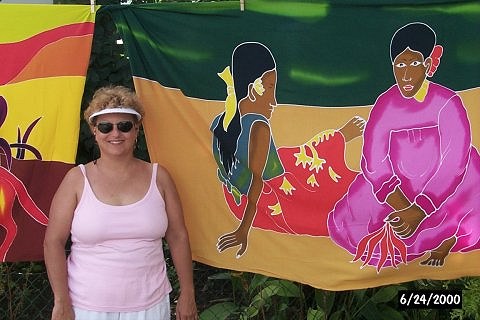Paul Gauguin can take a lot of the credit, and the blame, for the over-glamourisation of Polynesia.
He led the perfect 'Riches to Rags' legend of a Great Artist, giving up his wife, family, and plodding stockbroker's job to go off, way beyond the Far East, to those fabled isles where noble savages lived in loving, primitive innocence, picking their daily bread fruit from the nearest tree.
His images have given us much of our mental picture of the South Seas.
His well-known depictions of paradise on earth have led us to this:
and this: So how did he do it? Just how did he paint pictures that, a century on, would still influence retirees from Florida to ride a floating apartment block halfway across the Pacific Ocean?
So how did he do it? Just how did he paint pictures that, a century on, would still influence retirees from Florida to ride a floating apartment block halfway across the Pacific Ocean?
We'll take a critical look at this famous painting, Ta Matete, painted in 1892.

It would cost you a few million dollars nowadays, if you ever have any opportunity to buy it.
It's a definite Classic.
But it's a fake.
That's not to say that some forger other than the great artist, Paul Gauguin himself, actually daubed this awful thing, but that the great artist, Paul Gauguin himself, was a total phony from the very start.
Firstly, he deliberately incorporated some Ancient Egyptian pictorial conventions into his picture, copying well-known images like this one: (he probably picked up one of those Egyptian souvenirs sold by hucksters in Suez - (actually, I'm not at all sure that the Suez canal was actually there when Gauguin travelled east - I will check that out, but I think he must have been, as he wasn't the sort who would endure a long trip around the Cape)
 Notice how the girls' legs point left, at very precise angles. Their upper arms are shown at a very distinct angle, and their forearms are held precisely, either slightly down, or about the same degree up.
Notice how the girls' legs point left, at very precise angles. Their upper arms are shown at a very distinct angle, and their forearms are held precisely, either slightly down, or about the same degree up.
The Ancient Egyptian jobbing painters who created this picture, still fresh on its desert tomb wall after 30 centuries were no revolutionaries; they were following, very strictly, standards that had long before been laid down by their great-great-grandfathers.
But Gauguin was a Revolutionary Modern Painter
He also copied those details, but still couldn't get them quite right.
The French (under Napoleon) had invaded Egypt almost 3 generations before Gauguin arrived in Tahiti, and these images had been around for very nearly a century.
Paul Gauguin - Revolutionary Artist? - not quite.
But he did lead the kind of life that a pimply adolescent (as I was when he was my hero, with pretensions to becoming a similarly Great Artistic Genius) could sympathise:
Gauguin was attracted to Tahiti however not only as a means of escape and renewal (by a return to origins) but also because it provided new subjects for his paintings and because life there was said to be free from all money difficulties' ...one has only to raise an arm to find food'. http://www.janesoceania.com/tahiti_gauguin1/
Escape? Renewal? Return to origins? Wonderful stuff.
And...free from all money difficulties? Even better ! 
There are a few other revealing points about this famous painting. Look at it again, without your 'South Pacific' pink tinted glasses.
The graceful Egypto-Tahitian ladies sitting decorously on their traditional South Sea Island bench, fanning themselves quietly and modestly, are nothing of the sort.
They are, in fact, the town prostitutes. They are delicately fanning themselves with their official medical papers, issued by the Medical Officer of Papeete, certifying that, following his latest intimate inspection, these young ladies are clear of venereal diseases, and fit for carnal use by the sex-deprived matelots of the French Navy, currently on a port call, if they can can afford them.
And there's more. After several months he moved some 25 miles from Papeete and went to live in a bamboo hut, with a thirteen-year-old Tahitian girl as his vahine; he dressed himself like the natives, went on fishing expeditions with them and tried to familiarise himself with their customs and way of thought.
After several months he moved some 25 miles from Papeete and went to live in a bamboo hut, with a thirteen-year-old Tahitian girl as his vahine; he dressed himself like the natives, went on fishing expeditions with them and tried to familiarise himself with their customs and way of thought.
http://www.janesoceania.com/tahiti_gauguin1/
If Gauguin had been a Salon-exhibiting painter of today, he'd very rightly be denounced as a paedophile, and quite possibly be considered seriously for a lynching, by the very same type of people who now visit Tahiti in their floating condos, inspired by the Legend of the Great Artist.
Gauguin died on 8 May 1903, in the Marquesas, where he had moved for a cheaper life. He had already suffered the effects of syphilis, and his legs were covered with open sores. Repeatedly in debt, he suffered spells of intense depression which reached their climax in January 1898 when he tried to commit suicide by taking arsenic.
But:
He had become a legend even in his lifetime. 'You are now,' so Monfreid wrote to him in December 1902, 'that unheard-of legendary artist, who from the furthest South Seas sends his disturbing, inimitable works, the definitive works of a great man who has as it were disappeared from the world.'
This article owes a great deal, including the pictures to: TAHITI - The Story Of Paul Gauguin and it's only fair that I urge you to visit there and read the much more wholesome legend of Paul Gauguin.

No comments:
Post a Comment